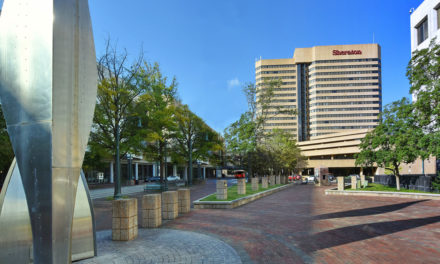Memphis is public safety poor.
As we pointed out in yesterday’s post, the budgets of the police and fire divisions are more than all of the City of Memphis property taxes and sales taxes combined. In fact, the two major revenue sources for city government still come up $52 million short in covering police and fire operations.
In polling and public processes, Memphians have said that they want more money spent on their neighborhoods and that prime sources for the funding are the police and fire divisions’ budgets. And yet, the police department budget continues to climb and neighborhood quality of life services like libraries, community centers, parks, and anti-blight programs are underfunded.
Or put another way, all other services of city government have been cannibalized little by little to pay for the growing budgets of the fire and police departments. But everything in a city is connected, so it’s possible that lack of funding to cut weeds in city parks or abandoned lots, to fight blight, to fund activities at libraries, parks, and community center activities could have impacts on the crime rate too.
Hoisted On Your Own Petard
Between 2006-2012, the number of sworn officers in MPD increased by 426, and while they respond to about one million calls a year, only about 50,000 are Part I Uniform Crime Report offenses (violent crime) and about the same in Part II crimes (generally property).
That’s why the so-called “full service police department” description is misleading. MPD isn’t delivering full service; in truth, it’s providing services that belong to other divisions or to civilian workers, or aren’t required at all. As a result, many of today’s functions make no sense budgetarily nor are they the smartest deployment of personnel.
It’s often hard to understand how one element of the city budget was able to consume such a disproportionate percentage of the city’s total expenditures. As we have pointed out before, the amount of the increase in the police department budget (about 25% since 2008) also happens to be roughly the amount of money needed to fully fund the city pension plan.
In other words, it can be said that the current pension crisis is of the police department’s own making, a fact ignored when police union officials are railing against city government for proposing changes to the pension plan that would make it financially sustainable.
The Disconnect
In the face of the yearly plea by police administrators and union leaders for more and more money for their operations, it’s next to impossible for elected officials to say no for fear of paying a political price for being “soft on crime.” The same dynamic played out on the county government side of the street as the board of commissioners over the years has increased the sheriff’s budget while all other services were being cut back.
But there may be another reason that police budgets have climbed so dramatically. There’s no counter balance to climbing costs and no incentive to cut costs because city government doesn’t have a jail. For example, many cities across the U.S. have developed innovative intervention programs and juvenile diversion programs in order to reduce their jail costs, but here, MPD can act on a “lock ‘em up” attitude because upon their arrest, defendants are driven to the Shelby County Jail where they are processed and booked, and where the costs in the criminal justice system are borne by county government at a clip of more than $30,000 per person per year.
When he was sheriff, Shelby County Mayor Mark Luttrell said the “lock them up” strategy that processes 60,000 people (some of them multiple times) through Shelby County Jail every year is the easy part, but it’s the “other two legs of the stool” that need equal attention and emphasis: prevention and intervention.
More Than One-Trick Pony
Much of that prevention and intervention could take place in city parks, community centers, outreach programs, youth programs, and libraries, but then again, there’s no money for that because prevention and intervention are sacrificed on the altar of crime suppression.
Some of the alternative crime reduction programs could be teen courts and family-based therapy for juvenile offenders, restorative justice for low-risk offenders, employment and job training for prior offenders, intensive supervision, and community-based drug treatment programs.
“Crime reduction requires a balance between investments in prevention and policing to achieve crime reduction based on research and cost-benefit analysis,” according to PFM, the consulting firm that wrote the five-year fiscal plan for City of Memphis. “If the City chooses to continue its reliance on policing as its primary means of achieving crime reduction, it must find a way to pay for it – the current method is fiscally unsustainable…the City cannot afford the current level of police FTEs.”
But, Memphis Police Department has also been neglectful in applying technology to its operations (of course, in our local government, it’s not alone). For example, there is the need for GPS in squad cars so that dispatching is more efficient and economical, for digitized reporting processes to eliminate duplications in the present system, and for cameras in high-crime and highly frequented locations.
Police administrators say they don’t have money for technology improvements, but then again, it’s largely because they’ve chosen to spend their money on more people than better systems.





When budgets run amuck, it’s almost always a management problem at the core. In the corporate world raiders, activist investors and private equity firms keep abusive management teams honest and in the extreme bankruptcy courts do so (General Motors). One way or another change comes. The voters are the ultimate board of directors for the City of Memphis. If the voters don’t take responsibility for making the hard decisions, someone else will, very probably the bond markets. At that point current management will be thrown out and replaced from afar, either by a bankruptcy judge or a receiver from Nashville. Those results won’t be pretty, but they inevitable on the current course.
As a small example, last night I attended the James Taylor concert at Mud Island. This event brought in $400,000-500,000 not counting hotel stays and post concert bar tabs. Despite this venue’s importance to the City of Memphis, the city garage at the monorail station, front door to Mud Island and across the street from City Hall, is in terrible disrepair and generally filthy. At the venue itself the rest room facilities are grossly inadequate. We saw one working listlessly and ineffectually pushing trash around with a broom, but clearly there is no one in charge demanding that this facility be run in a way to assure a quality experience for the patrons. If this is indicative of the way other city departments are being run, it comes as no surprise that public safety budgets are out of control. The first place to start is with a tough minded City appointed Czar with the power to restructure the departments, control budgets and demand optimal performance for the dollars spent.
We are lucky that you continue asking smart questions about all things Memphis, Tom. This is an important analysis. You wonder why the daily newspaper can’t figure this out so it gains a wider audience. I know SC Memphis reaches the leadership. Let’s hope this becomes the subject of serious conversation around town.
Responsibility for this sad state of Memphis’s finances rests with our leadership, the Mayors. I think there is enough lack of responsible leadership to be shared by both our city Mayor and our county Mayor. If they were corporate CEOs, they both would have been replaced by their respective Boards of Directors.
And since the corporate leadership of Memphis heavily influences our Mayors’ actions, they can share in the responsibility for our problems.
With some exeception, Mike Ritz for example, the members of our city and county legislative bodies have no vision and no solutions, so it becomes the Mayors’ reponsiblities to PUSH for the changes needed. If they spent the same amount of time bringing solutions to our challenges to the people as they do running for election, maybe we could have the changes needed begun. What if Mayor Luttrell spent the same funds he uses for reelection on selling the electorate on the reasoning for making the hard changes that we need to make. And what if Mayor Wharton took some of the money he has for a future campaign to do the same. And what if the business leaders who put the money into the campaigns insisted it be spent in such a manner.
What if…
MIKE RITZ has visions, allright. And after his next (last) Commission meeting he will be free to drop his meds entirely and focus on ’em.
Mostly safe in his germantown garage blowing up a scale model of the munis
and rewriting the State Constitution to fit his notion of Triumph of the Will.
I don’t see many comments here, it means you have low traffic. I know how to make your page go viral. If you want to know simply search in google for:
Kimting’s Method To Go Viral